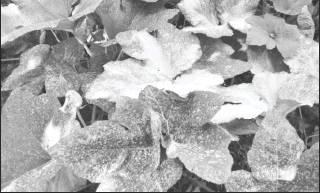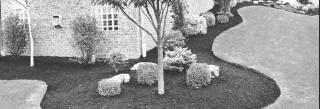Joe Urbach to speak at Wimberley Garden Club
Joe Urbach
Columnist
Master Gardener, and Century News Drippin’ Gardening columnist Joe Urbach will present “The Moringa Tree: What you don’t know can HEAL you!” at the Wimberley Garden Club’s first meeting of the 2018-2019 season on Wednesday, September 12, at the Lutheran Church of the Resurrection, 101 W. Spoke Hill Dr. in Wimberley. Urbach will discuss the medicinal and nutritional aspects of the unique tree that he calls a “superfood treasure.” Breakfast goodies are served at 9:30 a.m. and the program starts at 10. Guests welcome. The club meets the second Wednesday of each month September to May; guests and prospective members always welcomed. Annual dues are $20. Contact [email protected]. and follow monthly programming on facebook.
I love answering garden questions. One I get asked frequently concerns Powdery mildew, but you know what? I don’t really see it as a major garden problem here in Dripping Springs. But still, it is one of the most common problems I am asked about, so let’s see if I can address some concerns about this common/uncommon issue.
First of all, you should understand that Powdery Mildew is one of the easiest diseases to recognize as it looks just like its name. The mildew will form a white or gray powdery film on a plant's leaves, stems, and fruit. Powdery mildew is a fungal disease caused by the many varieties of the fungi that belong to the order Erysiphales and each species attacks a different range of plants. In fact, this is one of the most widespread fungal diseases and attacks among the widest range of plants on the planet. You may see mildew on a variety of trees, shrubs, flowers, vegetables and lawn grasses. The fungus thrives in warm, humid environments, and overwinters in the soil. The mildew forms spores that spread through wind, insects, and water run-off, which carries the disease to other plants. In my garden, when I do see powdery mildew show up, I most often find it on my Rock Roses.
Powdery mildew is almost unavoidable with Pavonia lasiopetala (Rock rose). Many plants with woody stems and fuzzy leaves struggle with this nuisance. Powdery mildew is a common fungal infection so don’t be too surprised if it makes an appearance. Really hot sun helps reduce the chance of mildew forming so I don’t often find that it is an issue during our summer months. But as we are now moving towards autumn, with cooler temperatures and more rain likely, it may start to make its unwelcome presence known.
Another thing you’ll want to do is to understand that it is important to make sure that this plant has good drainage. Although poor drainage isn't the cause of the mildew, the combination of soggy roots with mildew can stress out the plant enough to kill it, plus the poor drainage will increase the humidity around the plant. Pavonia also likes to be cut back every year, keeping it from becoming leggy. Some theorize that if you do this twice a year rather than once, it helps keep the mildew away. Even in the hottest summer though you’ll sometimes see the disease start to crop up. From my own experience I can tell you that I thin my rock roses and all of my garden regularly to insure that there is plenty of air flow in and among the leaves of all the plants. I find that this simple step helps to ward off powdery mildew rather well. Once mildew develops you may find that it returns again and again, even in the hot sun of summer. Other than being susceptible to powdery mildew, Rock Rose is a tough little plant. Well, worth fighting for.
But enough about the Rock rose, let’s get back to Powdery Mildew. The good news is that powdery mildew can be beat. Often you can beat it by removing affected plants and opening things up to allow more air flow. In the worst cases you can attack it with simple household ingredients. Use one half tablespoon of baking soda and a couple of drops of dishwashing soap (something natural if you can) mix it up with one half gallon of water in a spray bottle and spray the leaves. This changes the PH on the leaves slightly making it tough for mildew to form and spread. Baking soda has a pH of 9, which is very high! Treating with baking soda raises the pH level on the plants and creates a very alkaline environment that kills fungus. There have been mixed reports of success when using baking soda to treat severe cases, so it may be better as a preventative treatment than a fungicide.
In gardening circles, we often talk about something we call the “Disease Triangle.” Basically, it means that diseases occur when the fungal organism and susceptible plants are present together and the environmental conditions are right for the disease to occur. The three sides of this triangle then are, a fungal organism, susceptible plants, and the proper environmental conditions. Remove any one of these factors and you eliminate any chance of the disease occurring. This means that there are some things you can do to reduce or remove the risk of powdery mildew.
Powdery mildew is most common during hot, dry weather. Wait a minute! Didn’t I just say that I don’t run into it during our hot summers? Yes, I did, it likes hot dry weather but not like the heat we get in July and August! It seems to like the spring and fall heat ranges better. Wet foliage does not increase the risk of this disease, but high humidity does. You’ll typically see more mildew problems in damp and shady locations with crowded plantings.
You can’t change the weather, but by insuring good drainage you can avoid creating high humidity micro-environments, so adding compost to your planting beds to improve the soil drainage is a great idea. Additionally, you should avoid purchasing mildew-susceptible plants to begin with. Instead, select disease-resistant varieties whenever possible. Further decrease the risk by growing plants at the recommended spacing in the preferred amount of sunlight. Giving plants room to reach full size ensures they will receive sufficient sunlight and air circulation, thus reducing the risk of diseases. Your plants will be healthier and better-looking when they have space to show off their beauty!
Grow vine crops like cucumbers and squash on trellises and fences to accomplish the same results. Avoid excessive nitrogen fertilization meant to encourage lush succulent growth. Nitrogen makes some plants more susceptible to this and other diseases, as well as many insect problems. Consider using low-nitrogen, slow-release fertilizers that promote slow but steady growth above and below ground as this makes for a much healthier plant.
If mildew continues to be a problem and is impacting the health and beauty of your plants, you may decide to intervene. This is when I break out the baking soda and dish soap mix and start to spray.
My grandmother used to treat her infected plants with milk. As it turns out numerous studies have shown milk and/ or whey to be even more effective at killing powdery mildew than chemical fungicides. In a 2009 study by the University of Connecticut, which tested a milk treatment of 40% milk and 60% water on plants infected with powdery mildew, "the milk treatment provided significantly less disease than the untreated control, and the chemical treatment had equal or significantly less disease than the milk."
Scientists are not sure why milk is so effective, but they believe that when milk interacts with the sun, it produces free radicals that are toxic to the fungus. Thorough coverage of the upper and lower leaf surfaces and stems will improve your success rate with either spray.
Check plant tags, purchase wisely and adjust plant maintenance to reduce powdery mildew problems in your landscape. A bit of prevention now and then, along with proper care go a long way to reducing the time spent maintaining healthy, productive and beautiful gardens and landscapes.






